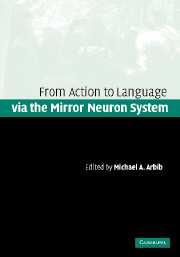Crossref Citations
This Book has been
cited by the following publications. This list is generated based on data provided by Crossref.
Byrd, Dani
Krivokapić, Jelena
and
Lee, Sungbok
2006.
How far, how long: On the temporal scope of prosodic boundary effects.
The Journal of the Acoustical Society of America,
Vol. 120,
Issue. 3,
p.
1589.
Hallé, Pierre A.
and
Best, Catherine T.
2007.
Dental-to-velar perceptual assimilation: A cross-linguistic study of the perception of dental stop+/l/ clusters.
The Journal of the Acoustical Society of America,
Vol. 121,
Issue. 5,
p.
2899.
Schaal, Stefan
2007.
The new robotics—towards human‐centered machines.
HFSP Journal,
Vol. 1,
Issue. 2,
p.
115.
Arbib, Michael A.
and
Bonaiuto, James
2008.
From grasping to complex imitation: mirror systems on the path to language.
Mind & Society,
Vol. 7,
Issue. 1,
p.
43.
LaMendola, Walter
and
Krysik, Judy
2008.
Design Imperatives to Enhance Evidence-Based Interventions with Persuasive Technology: A Case Scenario in Preventing Child Maltreatment.
Journal of Technology in Human Services,
Vol. 26,
Issue. 2-4,
p.
397.
Schuboe, Anna
Maldonado, Alexis
Stork, Sonja
and
Beetz, Michael
2008.
Subsequent actions influence motor control parameters of a current grasping action.
p.
389.
ARBIB, MICHAEL A.
2008.
Handbook of the Neuroscience of Language.
p.
237.
Ellison, Peter T.
2009.
Book Review: A Growing Thought.
Evolutionary Psychology,
Vol. 7,
Issue. 3,
p.
147470490900700.
Zelaznik, Howard N.
and
Goffman, Lisa
2010.
Generalized Motor Abilities and Timing Behavior in Children With Specific Language Impairment.
Journal of Speech, Language, and Hearing Research,
Vol. 53,
Issue. 2,
p.
383.
Larangé, Daniel S.
2011.
Neurosémiotique et bouddhisme.
Protée,
Vol. 39,
Issue. 2,
p.
31.
Hernández-Sacristán, Carlos
Rosell-Clari, Vicent
and
MacDonald, Jonathan E.
2011.
Proximal and distal. Rethinking linguistic form and use for clinical purposes.
Clinical Linguistics & Phonetics,
Vol. 25,
Issue. 1,
p.
37.
Larangé, Daniel S.
2011.
La neurosémiotique.
Protée,
Vol. 38,
Issue. 3,
p.
39.
Macedonia, Manuela
Müller, Karsten
and
Friederici, Angela D.
2011.
The impact of iconic gestures on foreign language word learning and its neural substrate.
Human Brain Mapping,
Vol. 32,
Issue. 6,
p.
982.
Andreae, John H.
2011.
A Multiple Context Brain for Experiments With Robot Consciousness.
IEEE Transactions on Autonomous Mental Development,
Vol. 3,
Issue. 4,
p.
312.
Gilmore, Paul
2012.
The Oxford Handbook of Nineteenth-Century American Literature.
p.
327.
Caselli, Maria Cristina
Rinaldi, Pasquale
Stefanini, Silvia
and
Volterra, Virginia
2012.
Early Action and Gesture “Vocabulary” and Its Relation With Word Comprehension and Production.
Child Development,
Vol. 83,
Issue. 2,
p.
526.
Nam, Hosung
Mitra, Vikramjit
Tiede, Mark
Hasegawa-Johnson, Mark
Espy-Wilson, Carol
Saltzman, Elliot
and
Goldstein, Louis
2012.
A procedure for estimating gestural scores from speech acoustics.
The Journal of the Acoustical Society of America,
Vol. 132,
Issue. 6,
p.
3980.
Bowers, Andrew
Saltuklaroglu, Tim
Harkrider, Ashley
Cuellar, Megan
and
Sinigaglia, Corrado
2013.
Suppression of the µ Rhythm during Speech and Non-Speech Discrimination Revealed by Independent Component Analysis: Implications for Sensorimotor Integration in Speech Processing.
PLoS ONE,
Vol. 8,
Issue. 8,
p.
e72024.
Hertrich, Ingo
and
Ackermann, Hermann
2013.
Neurophonetics.
WIREs Cognitive Science,
Vol. 4,
Issue. 2,
p.
191.
Palm, Günther
and
Glodek, Michael
2013.
Neural Nets and Surroundings.
Vol. 19,
Issue. ,
p.
323.





